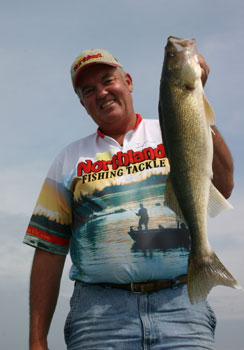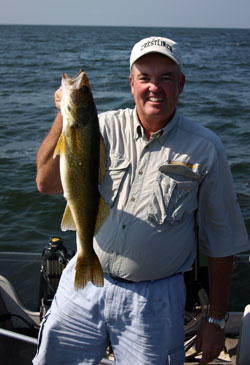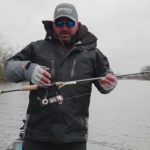Getting Down with Heavy Duty Walleyes
 It seems a little complicated at first glance, but trolling with leadcore is easy enough and a terrific way to get a crankbait to run exactly where you want it. The idea is to get a crank running at the right depth and the right speed and put it in front of as many fish as
It seems a little complicated at first glance, but trolling with leadcore is easy enough and a terrific way to get a crankbait to run exactly where you want it. The idea is to get a crank running at the right depth and the right speed and put it in front of as many fish as
possible. It’s a super late summer and early fall presentation that lets you cover plenty of ground and the extra speed might be exactly what ol’ marble eyes is looking for.
Getting a bait to run at a particular depth isn’t all that tough, and can be simply a matter of selecting a bait that will reach a maximum running depth that falls within a foot or so of a productive zone. It’s when you have a varying bottom that things get a little
tricky, especially if you’re faced with constant depth changes. Keeping a bait running where you want it takes too much time and too many adjustments to really be efficient, especially if you’re using standard trolling techniques.
Standard techniques include flat lining cranks, using super braids ( which can increase maximum diving depths ), and adding weight in the form of inline sinkers and snap weights. An excellent option that is underutilized and often misunderstood is trolling
with leadcore which is a weighted line. Leadcore allows you to basically troll any crankbait you like at any depth you want. That means trolling shallow running baits like a number five Jointed Shad Rap in deep water ( as deep as you need ), and deep running
baits like Reef Runners in even deeper water. It will also allow you to get to specific depths with a minimum amount of line out which gives you more control.
 Using a minimum amount of line can allow you to quickly adjust to a depth change which will keep your bait in the zone longer and make you much more efficient. Another advantage to leadcore is its lack of stretch which will transfer the action of a properly running crankbait to your rod tip. By watching the tip you can actually see the rhythmic vibrations of clean running bait. If a bait is fowled you’ll know by a lack of action in the rod tip. Because you can see it and because you have a minimum amount of line out you can quickly reel a fowled bait in and get it back in the water, thus saving valuable time. You can also see if a bait is digging into the bottom, which allows for quick and accurate depth adjustments. A bait dragging across the bottom will be indicated by a rod tip that is pulled back and then snapped forward, and you my even see the wiggle of the bait in between. In most cases you’ll probably be trying to get a lure to run close but not on the bottom.
Using a minimum amount of line can allow you to quickly adjust to a depth change which will keep your bait in the zone longer and make you much more efficient. Another advantage to leadcore is its lack of stretch which will transfer the action of a properly running crankbait to your rod tip. By watching the tip you can actually see the rhythmic vibrations of clean running bait. If a bait is fowled you’ll know by a lack of action in the rod tip. Because you can see it and because you have a minimum amount of line out you can quickly reel a fowled bait in and get it back in the water, thus saving valuable time. You can also see if a bait is digging into the bottom, which allows for quick and accurate depth adjustments. A bait dragging across the bottom will be indicated by a rod tip that is pulled back and then snapped forward, and you my even see the wiggle of the bait in between. In most cases you’ll probably be trying to get a lure to run close but not on the bottom.
Good trolling equipment includes longer baitcasting rods combined with larger capacity reels. My Cabela’s Depthmaster reels have the capacity needed to get down to just about any depth I need and that typically means at least seven or eight colors.
Depending on the depth you want to achieve it may require five or six colors of leadcore or more to get the job done which will quickly fill up the smaller reels. Rods in the seven to eight foot range with softer action tips are in order and can mean more fish boated. The longer softer rods will help compensate for the lack of stretch in the leadcore line and give you some needed fish fighting power.
The weight of leadcore you chose can vary but something in the eighteen to twenty-seven pound range will do just fine. As mentioned earlier leadcore is colored, and each color represents 10 yards of line. A good rule of thumb is that each color can achieve an additional five to six feet of diving depth.
The most misunderstood part of the whole program is the leader which is a portion of monofilament that separates the leadcore from the crankbait. A eight or ten foot section of twelve pound test mono in an abrasion resistant line is what you’re looking for and
about all you need. If you do use a longer leader you’ll have to figure that into the running depth equation. To attach the mono to the lead you can use a small crane swivel or you can pull back the sheath on the leadcore, remove a chunk of lead, and then tie an
overhand know. You can then tie a nail knot with the mono and snug it up to the overhand knot. It’s plenty strong (when done right) easily reels up through the rod guides and into your reel.
The thing is; don’t worry about being perfect first time out and fortunately you don’t have to be to catch fish. However the more you do it the better you’ll become the more areas you’ll find to give it a try. See you on the water.





